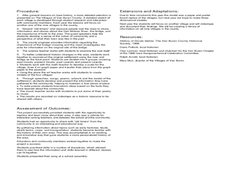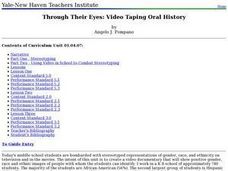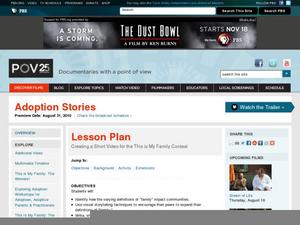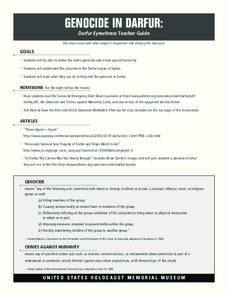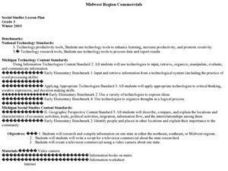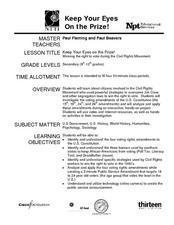Curated OER
Lights, Camera, Campaign
Students employ their technology skills to produce campaign commercials. In this political campaign lesson plan, students discover the appropriate uses of video cameras and create fictitious campaign commercials.
Curated OER
Sense of Place: No River Too Wide-Bridges
Fifth graders discover the history of their hometown Des Moines River. In this U.S. Geography lesson students speak with Iowans that tell stories of the settlers and early villages near the Des Moines River. Students document...
Curated OER
Through Their Eyes: Video Taping Oral History
Middle schoolers identify the stereotypes they are faced with on a daily basis. In groups, they use this information to identify the ways stereotypes are portrayed in movies and television. They use a video camera to record oral...
Deliberating in a Democracy
Surveillance
Big Brother is always watching you! Scholars analyze the impact security cameras have on the legal system in a democracy. Primary documentation, case studies, and video clips investigate the use of video in prosecution and provide an...
Curated OER
What's in the Time Capsule? A Technology-Connected Lesson Plan
Twelfth graders use computers and the Internet to research a specified area, word processors to prepare an essay, a digital camera, a video camera gather visuals, and a scanner to add visuals to a PowerPoint presentation as they discover...
Curated OER
21st Century Social Skills
Explore communication techniques by using the latest video technology. In this special education lesson, students create a video discussing their own social goals for the future. Students utilize Flip Video cameras to...
Curated OER
You Can Do It: Creating How-To Videos
Students create instructional videos. in this video lesson, students choose a subject area and topic to make their own how-to video. They research this topic and film their video using a flip-camera.
Curated OER
Adoption Stories
Although originally designed for young film makers who wanted to enter their videos in a contest, the step-by-step instructions included here would serve as a guide for any video project. Classes with no access to video editing software...
Curated OER
SPEECHES TO INTRODUCE
Pupils create multimedia speeches of introduction which focus on women and Hispanics. They introduce their famous person and, using a video camera, video tape their speeches.
Curated OER
Shaking the Movers: Youth Rights and Media
Children have rights! Exploring those rights and using media to express those rights is the focus of this Media Awareness Network lesson. Although some of the law links reflect the Canadian Articles of The Convention, the majority of the...
Curated OER
Privacy in the Age of Video Surveillance: This Is Not Your Father's Candid Camera
Eighth graders examine the use of video surveillance in the corporate world and other life situations. In groups, they determine how many times and in what situations they believe they are being watched. They use the Constitution to...
Curated OER
Lights, Camera, Action...Crossing the Delaware in 9 Scenes
How does reading a drama differ from reading a novel? Middle schoolers become playwrights and explore these differences. After viewing the A&E movie,"The Crossing," groups create stage directions, write dialogue, and design sets and...
Curated OER
What is American Culture
Students create what they feel is American Culture using a video camera and capturing 5 frames. They are animating parts of a poem in small groups. They decide the set up, create movable figures, and have a music section. Each person...
US Holocaust Museum
Genocide in Darfur: Darfur Eyewitness Teacher Guide
The events of the Holocaust in World War II would never happen again, right? Scholars research the current genocide taking place in Darfur. Using video and Holocaust Reading Passages, they analyze the horror of this forgotten part of the...
Curated OER
Let's Travel
Students engage in Internet search. They find answers to questions concerning an assigned country. They create a video presentation about a foreign country. They design a display about the foreign country.
Curated OER
Architecture
Learners study tessellations and the work of M.C. Escher. They discuss the terminology of architecture, the historical significance of architecture in different parts of the world, and create their own piece of architecture out of...
Curated OER
Midwest Region Commercials
Third graders research their assigned state using a variety of resources including a website, books, and travel brochures. They complete questions on a worksheet to use when writing a commercial for the state. They film the commercial...
Curated OER
Keep Your Eye On the Prize
High schoolers learn about citizens who were actively involved in the civil rights movement, and the strategies they used to overcome the Jim Crow laws that were so prevalent in the 1960s. They investigate the voting amendments of the US...
Curated OER
Flip Camera Activity: Being a Good Citizen
Students make a video. In this citizen lesson, students discuss what a good citizen is. Students define what rights Americans have and write paragraphs about our rights and responsibilities. Students videotape their partner as they read...
Curated OER
American History Digital Movie
Fifth graders create a video. In this historical presentation, 5th graders watch a video clip of a dramatization of a historical event in American History. Students discuss how this video was put together. Students divide into small...
Curated OER
Louisiana
Students explore traditions of Louisiana. In this culture lesson, students discuss the traditions, food and culture of Louisiana. Students video themselves singing the state song to share with parents.
Curated OER
Living History: Documenting Our Senior Citizens Lives
Students investigate stereotypes by researching the elderly. In this senior citizen lesson, students interview elders in a rest home and video tape their experience. Students present their videos to their interview subjects after...
EngageNY
Building Background: A Short History of Human Rights
Before continuing to read the Universal Declaration of Human Rights, learners need to understand why and how this document was written. First, show and discuss a video from UNICEF to demonstrate the need for such a document. Then...

